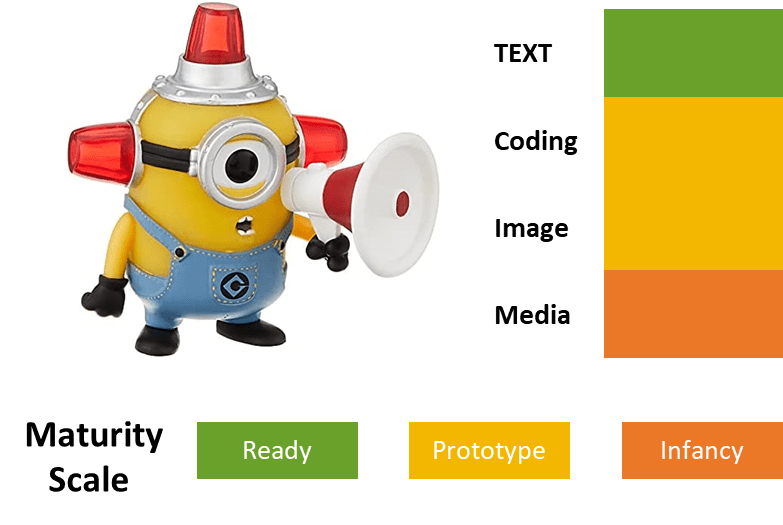What is Generative AI ?? ⠀⠀⠀⠀⠀⠀⠀⠀⠀
We humans had an edge on creative side compared to the computation task for which machines are may be bit ahead of curve, until now. The rise of Generative AI technology have enabled machines to generate sensical and beautiful new content, such as text, images, or music, based on a set of rules or guidelines.
Imagine you have a recipe for a cake. You know exactly what ingredients you need and how to mix them together to make the cake. Generative AI is like a robot that can follow that recipe to make the cake all by itself, without any help from a person. It can even come up with its own variations of the recipe by trying out different ingredients or changing the amounts of certain things. The key here is to ask exactly which cake you want and explain what ingredients you have.
Trip down the memory lane
One of the first examples of generative AI was ELIZA, a computer program created in the 1960s that could simulate a conversation with a psychotherapist. ELIZA used a set of simple rules to generate responses to user input, making it one of the earliest examples of a generative AI system. For decades researchers have continued to explore the potential of generative AI, developing new algorithms and techniques for generating text, images, and other forms of content. The introduction of backpropagation in the 1990's enabled neural networks to be trained to adjust their internal parameters based on the error between their output and the desired outcome, allowing them to learn from data in a much more effective way. This was game changing and enabled advancement of Convolutional Neural Networks (CNNs) and Recurrent Neural Networks (RNNs) also contributed to the progress of neural networks, and have now become a key component of many state-of-the-art AI models. In recent years, the field of generative AI has seen significant progress, with the development of powerful new AI models such as Generative Adversarial Networks (GANs) and variational Autoencoders (VAEs) that can generate realistic images, videos, and other forms of content.
Potential use-cases for Generative AI ?
Some of the popular applications of generative AI includes:
| Input | Output | Theme | Use Case | Example Platforms |
|---|---|---|---|---|
| Text | Text | Marketing | Copywriting, creative personalisation, SEO optimisation | Jasper AI (https://www.jasper.ai/) WRITER (https://writer.com/) |
| Video | Video / Text | Sales | Business development agumentation, Sales coaching | https://www.regie.ai/ https://www.oliv.a/ |
| Audio | Text / Audio | CRM | Customer service chatbots (answering tickets and queries) | https://symbl.ai/ https://forethought.ai/ |
| Audio / Text | Audio / Text | Talent Management | Performance management, Job interviews, Coaching, training | https://www.onloop.com/ https://www.converzai.com/ |
| Text | Text | Legal | Contract drafting, Legal validation / citations | https://casetext.com/ |
| Text | Text | Code creation | Natural language to generate code for softwares. AI pair programmer | https://mayalabs.io/ https://github.com/features/copilot https://debuild.app/ https://kombai.io/ |
| Text | Text | Code Documentation | Natural language to generate code for softwares. AI pair programmer | https://mayalabs.io/ https://github.com/features/copilot |
| Text | Image | Art Generation | AI system that can create realistic images and art from a description in natural language. | https://openai.com/dall-e-2/ https://midjourney.com/home/?callbackUrl=%2Fapp%2F |
| Text | Text | ML Model | Build, train and deploy AI models | https://huggingface.co/ https://replicate.com/ |
| Text | Audio | Voice Synthesis | Educational platform, training, Cognitive coaching | https://synthesys.io/ https://speechify.com/ |
| Text | Video | Video | Educational platform, training, Cognitive coaching | https://www.synthesia.io/ https://github.com/microsoft/VideoX/tree/master/X-CLIP |
| Text | Image | 3D modelling | Storyboarding for games, 3D video modelling | https://nv-tlabs.github.io/GET3D/ https://dreamfusion3d.github.io/ |
keeping your eyes peeled with the technology
The generative AI definitely would be disruption as it would strengthen the creative cycle between humans and machines on other tasks. But not all themes are matured enough for the use now.
For technology which is ready for use, question pertaining to issues like copyright, trust & safety and costs are far from resolved.
1.Misuse: Generative AI systems could be used to produce malicious content, such as spam, phishing attacks, or fake news. This can be difficult to detect and can have serious consequences, particularly when it comes to news and political events
2.Misrepresentation: Generative AI systems might produce content that is not clearly identified as being generated by a machine, potentially leading to confusion or deception. This can lead to discriminatory or unfair outcomes, and can be particularly problematic when the model is used in applications such as hiring or loan approvals.
3.Bias: Generative AI systems can perpetuate and amplify biases present in their training data, leading to discriminatory or unfair outcomes.
4.Lack of accountability: As the AI model generates outputs, it can be hard to understand how a decision was made, making it difficult to understand why the AI came to a certain conclusion or made a certain prediction. This can make it difficult to hold people or organizations accountable for the actions of AI systems, making it crucial to have transparency and explainability in the models.
5.Intellectual property issues: Generative AI systems may be used to produce content that infringes on the intellectual property rights of others.
6.Economic disruption: Generative AI systems may be able to produce content or perform tasks that could replace human labor, leading to job displacement and economic disruption
It's important to consider these risks and take steps to mitigate them as we continue to develop and use generative AI systems. This could include using techniques to reduce bias, developing methods to detect and remove misinformation, and implementing regulations to protect privacy and security.








Top comments (0)